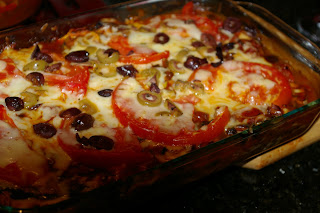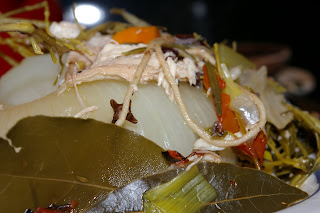I try to keep us on dietary track while also engaging in some fun-loving food activity. In keeping with that attitude, Friday night’s dinner was a slightly healthier eggplant parmesan. It’s basically the same as my “indulgent” version of the dish, with the significant difference being the treatment of the eggplant. In the richer version, slices of eggplant are coated in seasoned flour, egg wash, seasoned panko breadcrumbs, and are baked (not fried, at least) until the panko is nicely toasted and the eggplant slices are cooked through. It’s not fried, so what’s the problem? It ends up being a lot of bread crumbs; the full bread coating and the egg-glue cause the dish to seem a bit heavy. It’s – pardon me - (earmuffs) fucking delicious, but not what you would call “light”. Last night, I was feeling a tad porky. So I opted for the lighter version, wherein slices of eggplant and squash are grilled before being layered into the saucy cheesy goodness that is eggplant parm. Served with whole wheat spaghetti, of course.

 You can see from the photo above that I’m using a grill pan to “grill” the vegetables. Yes, clearly an actual grill would be preferable. If you’re going to try this recipe and have an actual grill, I fully encourage utilization of it. In our case however, there are three reasons the real grill was not used today: 1) I’m pretty sure we’re almost out of propane; 2) our kitchen is on the main floor of our townhome, and the patio with the grill is all the way in the basement (so it’s a real pain in the ass to haul our stuff all the way down there); and 3) “It’s hot outside”, says Jim (hereinafter referred to as “whiner” when the subject of outdoor heat is broached). Yes, it was 100 degrees outside today, with a heat index of 105; I can handle pretty hot weather, but Jim is not in my camp. The mere suggestion that he walk outside meets with a silent, steely eyed response.
You can see from the photo above that I’m using a grill pan to “grill” the vegetables. Yes, clearly an actual grill would be preferable. If you’re going to try this recipe and have an actual grill, I fully encourage utilization of it. In our case however, there are three reasons the real grill was not used today: 1) I’m pretty sure we’re almost out of propane; 2) our kitchen is on the main floor of our townhome, and the patio with the grill is all the way in the basement (so it’s a real pain in the ass to haul our stuff all the way down there); and 3) “It’s hot outside”, says Jim (hereinafter referred to as “whiner” when the subject of outdoor heat is broached). Yes, it was 100 degrees outside today, with a heat index of 105; I can handle pretty hot weather, but Jim is not in my camp. The mere suggestion that he walk outside meets with a silent, steely eyed response.
The roll call of cheese, clockwise from the back: mozzarella, aged provolone (sharp, nutty, salty, packs a punch), Asiago fresco (creamy, smooth, slightly tangy, melts very well), Stravechio parmesan (it’s not Reggiano, but it’s nearly as good and about $7 cheaper per pound), and Parrano (nutty, melts well also). Cheese is important to us; even our cats have been indoctrinated.
Finally, one more note before I get to the recipe. More of a guilty admission, really. Yes, that is a jar of premade pasta sauce. I’m not proud. But it’s a weeknight and it’s expedient (I know it’s Friday and we don’t have to be up early tomorrow, but I’m beginning my cooking at 7:45 pm, and we don’t really want to eat at 10). I can’t resist the temptation to doctor it up though, as detailed in the recipe below – in fact, if you do all of those steps to a plain canned tomato product, you’ll end up with a pretty good sauce – it just requires longer cooking on the stovetop.

Grilled Eggplant Parmesan
Serves 2, with a bit of leftovers; possibly one more without leftovers
Ingredients:
3 smallish eggplant, sliced in rounds of about ½ inch thickness (enough to make 15-20 slices)
2 yellow squash – I used patty pan here, but golden zucchini or regular yellow squash will also work well (even green zucchini if you prefer)
½ of a red onion, diced
1-5 cloves of garlic - large range given because I’m a garlic nut, but I realize that not everyone loves it as I do; I probably used more like 8 last night. But I’m garlic-crazed.
5-10 cremini mushrooms, cleaned and sliced - range given because of size differential; ours last night were enormous so I used closer to 5. If they were petite I would probably go up to about 10
½ red bell pepper, chopped into small pieces
1 large tomato, half of it diced into medium pieces, the other half sliced into thin rounds
1 jar of pre-made pasta sauce
½ c red wine – I used a cabernet sauvignon
1 14 oz can of diced tomatoes (no-salt-added is preferable)
Grated cheese – any varieties you like ( I think I sufficiently beat this to death above); I used at least 2 cups, I think – use as much or as little as you like (while understanding that the “health” quotient declines dramatically as more cheese is added)
2 cups chopped herbs – I used basil and marjoram; Italian parsley also makes a nice addition, and oregano can be used in place of the marjoram
¼ chopped olives - these are Nicoise and green greek olives – use what you like, but please, nothing from a can
Method:
First, get the sauce on the stove. In the same pot that you’ll later use to boil water for pasta, heat a bit of olive oil until shimmering on medium-high or high heat (depends on your stove). Add the onion, and cook until it’s softened and turning translucent. Add about half of the chopped mushrooms; and cook until the mushroom are very soft, the onions are getting a bit of browning on their edges and some brown fond is starting form on the bottom of the pan. Add the chopped garlic, and cook for about 1 minute. Add ¼ cup of the red wine, scrapping the bottom of the pan with a wooden spoon to loosen the fond that has formed. Cook until most of the liquid has evaporated, maybe 1-2 minutes. Add the chopped tomatoes, cooking until they let out most of their juice – maybe 2-3 minutes. Add the jarred pasta sauce, can of diced tomatoes, remaining wine, remaining chopped mushrooms, chopped bell pepper and any extra sprigs of basil, marjoram and/or parsley that you have sitting around (ad them whole – the stems give flavor, too; we’ll fish those out later). Cover and allow it to come to a simmer. Give it a stir every so often and cook uncovered for a bit it it’s getting too watery.

Now, deal with the eggplants. Cut the eggplants into rounds, about ½ inch thick. Place in single layer on a plate (reserving those that won’t yet fit); sprinkle with salt and repeat a second layer of rounds if you have more waiting. Cut your squash into similarly thick rounds and place on the eggplant plate.

To assemble the dish for baking: First, preheat the oven to 350. In a glass baking dish (this was
intended for 2 people, so I used an 11 x 7 dish), ladle some sauce on the bottom and spread to cover the entire area. Lay down eggplant and squash pieces in a single layer, fitting them together as much as possible (we’re aiming to have a second layer of veggies, so keep this in mind as you distribute them). Sprinkle the veggies with herbs, olives and then cheese. Dot sauce over the top of the veggie/cheese layer, and spread around a bit - but not enough to shift everything around in the pan. Put down one more layer of eggplant, hopefully using up all that remains. Cover with herbs, olives and cheese, as above, saving some of each of those ingredients for one more layer. Dot with sauce (as above) and sprinkle with additional cheese, herbs and olives. Top with sliced tomatoes and sprinkle a bit of extra cheese on top of the tomato slices. Cover with foil and bake until it’s hot and bubbly – maybe 20-25 minutes (it’s not long since everything we started with was hot but if you just used sauce right out of the jar that was cold, you might have to tack on some more time). About 10 minutes before you want to take the dish out, remove the foil. Once it’s out of the oven, give it a few minutes to sit before serving -it’s molten at this point.

During the baking, move any remaining sauce from the pot it was cooked in to another vessel (I used a 4-cup glass measuring cup). Wash out the pot and fill it with water to cook up the pasta. Use sauce that remains to stir into the cooked and drained pasta (after returning it to the pot), serving additional (heated) sauce at the diner’s option.


Dinner is served.


 Go-Lean Bars
Go-Lean Bars





 When the chicken is cooked through, remove the breasts from the soup to a clean plate. When cool enough to handle, shred the chicken into small pieces and return it to the soup. Add the wide rice, return the soup to a boil, cover, lower heat and cook until the rice is done, about 45-55 minutes. Add additional broth as necessary during the cooking to maintain the desired consistency. Before serving, remove the studded onion, bay leaves and bouquet garni (and celery tops if added separately). Serve, enjoy, heal.
When the chicken is cooked through, remove the breasts from the soup to a clean plate. When cool enough to handle, shred the chicken into small pieces and return it to the soup. Add the wide rice, return the soup to a boil, cover, lower heat and cook until the rice is done, about 45-55 minutes. Add additional broth as necessary during the cooking to maintain the desired consistency. Before serving, remove the studded onion, bay leaves and bouquet garni (and celery tops if added separately). Serve, enjoy, heal. 






 Marinade for Chicken (or any other meat) and Veggie Kabobs
Marinade for Chicken (or any other meat) and Veggie Kabobs

